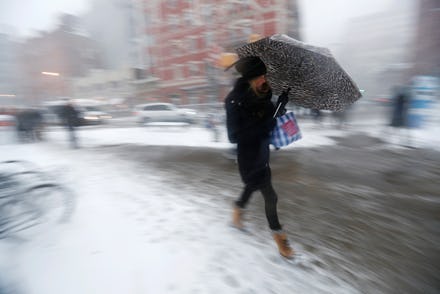No, Winter Storm Stella doesn’t disprove climate change

A massive winter storm is expected to wallop much of the Northeast United States on Tuesday, and could hit Boston and New York City with more than a foot of snow each. In what's become a seasonal tradition on social media, apparent climate change deniers have seized on this latest winter storm as in-your-face evidence that climate change doesn't exist — after all, how could "global warming" be real when your driveway is piling up with cold, cold snow?
Well, there's bad news for deniers — research has shown that extreme weather, for example, massive snowstorms, are actually linked to climate change. According to the Environmental Protection Agency, which has studied climate change extensively — although President Donald Trump has plans to gut its funding — winter storms have increased in both "frequency and intensity," and climate change is "increasing the odds of more extreme weather events taking place."
So that increase in intensity and frequency doesn't disprove global climate change — it may actually do the opposite. As meteorologist Eric Holthaus wrote in Slate in 2016, just after a record-breaking winter storm dropped 26.6 inches of snow on New York City in just one day, "there is clear evidence global warming is boosting the odds of recent big Northeast snowstorms."
And, as Grist reported on Monday, while big snowstorms that drop upwards of 20 inches of snow or more in the Northeast may seem like a run-of-the-mill part of winter, they're actually a deviation from the norm in some places, including in New York City. We've just gotten used to them over the past couple decades:
"For the first 126 years that meteorologists kept weather records at Central Park, from 1869 through 1995, they recorded just two snowstorms that dumped 20 inches or more. But since 1996, there have been five, and this week's storm could make it six."
It may seem counterintuitive that climate change, often referred to as global warming, would lead to big winter snowstorms, but, according to Slate, it's actually just basic physics. Warming waters means more moisture in the air, and more moisture in the air means more precipitation. And more precipitation is what's leading to current predictions of snowfall rates of up to 5 inches an hour on Tuesday.
As Grist reported, those snowfall rates would reach "the upper limit of what is physically possible in our current climate." So for those climate change deniers out there, it might be helpful to consider that the incoming major snowstorm that's about to slam millions of people isn't a reassuring return to normal winter weather — it's most likely just more evidence of an unstable and increasingly volatile climate.